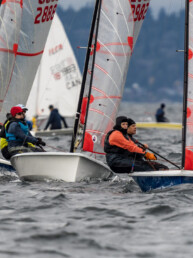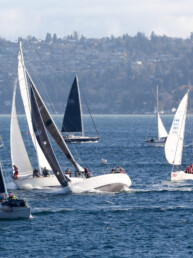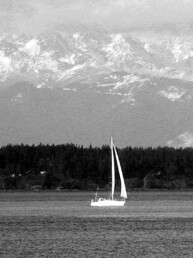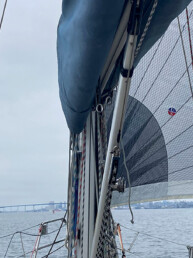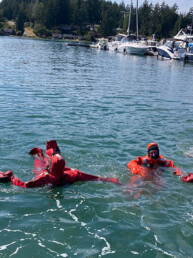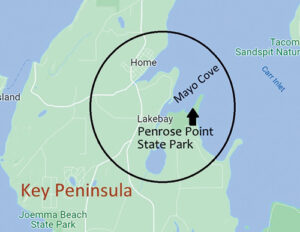 You know a place like this. It is a secluded, cherished cove seemingly frozen in time. Most boaters have at least one. Mine is located on the east side of the Key Peninsula in south Puget Sound. The site is hardly a secret — it includes a highly-publicized state park — yet it remains an “in between” spot, off the heavily trafficked route between Olympia and Tacoma. My husband Frank and I spent a memorable weekend here with our friend Mike, who camped on shore near Murrelet, our docked sailboat.
You know a place like this. It is a secluded, cherished cove seemingly frozen in time. Most boaters have at least one. Mine is located on the east side of the Key Peninsula in south Puget Sound. The site is hardly a secret — it includes a highly-publicized state park — yet it remains an “in between” spot, off the heavily trafficked route between Olympia and Tacoma. My husband Frank and I spent a memorable weekend here with our friend Mike, who camped on shore near Murrelet, our docked sailboat.
Mike drove his truck while Frank and I arrived as we often do — by water. Coast Salish canoes made of cedar have landed in this spot for centuries, bringing Sqauxin, Nisqually, and Puyallup people to harvest salmon, gather shellfish, and trade. Settler colonists came by boat in the days before paved highways allowed cars to probe the nooks and crannies of the South Sound.
“How do I get there?” asked Mike when I invited him to join us on the key-shaped peninsula extending into Carr Inlet to the east and Case Inlet to the west. His question stumped me. Here is what I knew: sail east through Dana Passage, round Devil’s Head, then cruise northward through Balch Passage and around Penrose Point. Of course, such directions were not helpful to a driver. Like many places in the Salish Sea, Mayo Cove is best approached in a boat, chart in hand.
The Magic of Mayo Cove
At first, we are disappointed that it is raining. Water flows, trickles, drips, and condenses throughout Mayo Cove, seeping into everything: the structures dotting the shoreline, the wooden docks, our boat, even our foulies. The three of us decide to explore anyway, climbing into the dinghy and leaving Murrelet at the Penrose Point State Park dock. The depth is shallow here, and we poke through the marshy vegetation, admiring the deep greens of the Douglas fir and cedar trees and the yellows and reds of the late September maples. We pass a boathouse that had seen better days. “How old is that?” Frank asks the two historians on board. “Probably built last year,” jokes Mike, noting that water seems to weather a building faster than any other element.

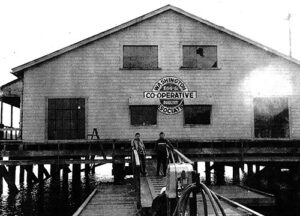
In Mayo Cove, the old and new blend seamlessly, making it easy to imagine the scene before us in previous eras. This is a good place to read the waterscape, and we spot evidence of past logging and farming, including stumps, berms, and remnants of orchards. Turning west, we notice old pilings under a dock at the Lakebay Marina, and stop to investigate a store at the deep end of the pier. Inside, the elderly proprietor serves us coffee and informs us that this once served as a landing for the Mosquito Fleet.
The Mosquito Fleet, a group of steamers and sternwheelers, carried passengers and freight throughout the waterways of Puget Sound during the early twentieth century, stopping at various settlements. While the original pier at Lakebay in Mayo Cove dates from the 1880s, the main building on the wharf was erected in 1928 and housed the Washington Cooperative Egg and Poultry Association. Here the Mosquito Fleet picked up local eggs, which were distributed throughout the region and transported to the East Coast and Europe, where inexpensive protein was highly valued during the Great Depression and World War II. Many residents of the Key Peninsula were members of the co-op. “The eggs were called cackleberries,” Catherine Williams, president of the Key Peninsula Historical Society, explained recently. “They had so much fruit out here… so why not?” (Key Peninsula News, April 1, 2019).
The co-op became an important site for social activities on the peninsula, attracting people to the pier and building. According to Williams, they arrived by boat, as the dirt roads were often muddy. Virginia Seavy, who arrived in Lakebay in 1918, recalled that “there were very few roads — mostly trails in the woods.” By the late 1950s, a network of paved highways and bridges had connected the Key Peninsula with the outside world, and the co-op’s Lakebay station closed. Throughout the late twentieth century, the dock and warehouse operated as a marina. The Pierce County Register of Historic Places listed the site in 2019, recognizing its significance in the development of the South Sound.
Across Mayo Cove just a few yards from the marina, the area around Penrose Point became a state park in 1987. Stephen Penrose, president of Whitman College, had owned this site, bringing his six children here every summer during the early twentieth century. The Penroses typically arrived on the steamer Tyrus to reach their family camp. Thanks to the state park, kids today continue to play on the shoreline and explore the forest trails winding along the water.
The combination of marina and park makes Mayo Cove an ideal destination for cruisers, offering early waterfront charm in a rural setting, as well as boating amenities. Penrose Park State Park provides docks on the Mayo Cove side, while buoys lure boaters to the Carr Inlet side. So appealing is the location that the Salish 100 small boat cruise stops here on its annual voyage from Olympia to Port Townsend. It is a perfect meeting spot for boaters and those arriving by land, which is what drew Frank, me, and our friend Mike here.
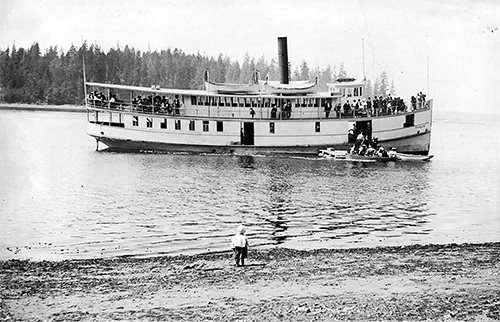
There’s No Place Like Home
The last stop on our dinghy ride is Von Geldern Cove (also called “Joe’s Bay”), just around the bluff on the northwest side of Mayo Cove. We putter toward the waterfront community of Home, armed with our well-worn, rain-soaked copy of Bailey and Nyberg’s Gunkholing in the South Sound, which informs us that this was once a “haven for free thinkers,” including vegetarians and nudists. As we glide along the forested shoreline, I read aloud to Frank and Mike, recounting how this quiet community made a splash in the region’s history.
Home was one of several utopian communities that emerged in western Washington during the late nineteenth and early twentieth centuries. In 1898, a group of settlers formed the Mutual Home Association, which intended to bring together individuals who valued “maximum liberty” without central organization or government. Local newspapers with evocative titles like New Era and Discontent: Mother of Progress, examined anarchist ideals and reported on the progress of Home, hoping to attract like-minded people.
Jay Fox, a Chicago anarchist and editor, arrived in Home in 1910 and began publishing The Agitator. “Home is a community of free spirits,” he explained in an issue in 1911. Its residents “came out into the woods to escape the polluted atmosphere of… conventional society.” The Agitator was filled with passionate and colorful rhetoric. Fox described President Theodore Roosevelt, for instance, as a “blatherskite,” “jabbering jawsmith,” and “inflated windbag.”
By 1910, Home had reached a population of 213, with nearly 70 residences. That year, Lucy Robins Lang and her husband Bob arrived in Joe’s Bay on a steamer, hoping to stoke their interest in anarchism and put down roots. The couple had lived in New York, Chicago, and San Francisco, demonstrating the connections of Home to the larger world. “We felt at once the fine atmosphere of freedom,” she wrote. “When we looked out… at the snow-covered peaks of Mount Rainier, glistening like a tiara of diamonds, we were sure that we should want to live here for the rest of or lives” (Lucy Robins Lang, Tomorrow is Beautiful, 1948).
Yet Lucy and Bob soon noticed “signs of strain at Home Colony.” External threats included national concern about the 1910 bombing of the Los Angeles Times building by labor activists, which cast suspicion on several Home residents. Around the same time, an internal rift between the “nudes” (those who wished to bathe naked in the waters of Joe’s Bay) and the “prudes” (who watched the unclothed with indignation and horror) emerged. Fox’s editorial on the controversy, which began “Clothing was made to protect the body, not to hide it,” got him arrested. He left Washington soon after, as did the Langs. In the end, the Home Colony “proved too much of a disillusionment” for the couple. In 1919 the Home Association dissolved, and the anarchist community broke apart (Lucy Robins Lang, Tomorrow is Beautiful, 1948).
Frank points our dinghy toward Carr Inlet, heading back toward Mayo Cove. The clouds have lifted and Mt. Rainier towers above the water. This is the scene that had enchanted Lucy Robins Lang, fueling her utopian dreams. That night, we build a campfire on shore and toast the early seafarers of Mayo Cove and the free spirits of Home.
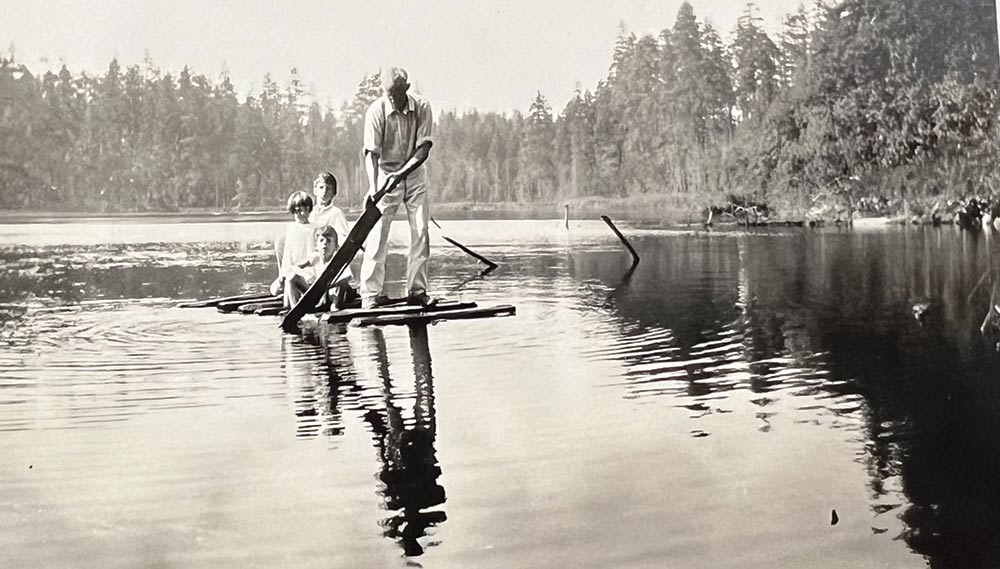
Marina Makeover
Recent efforts to bring Lakebay Marina back to its former glory will ensure that this historical site continues to charm boaters and inspire excursions like mine. The Recreational Boating Association of Washington (RBAW), Washington State Parks, and Washington Department of Natural Resources (DNR) have joined forces to preserve the pier, building, boat ramp, and tidelands for public recreational access. The marina has been purchased and the restoration project, which will likely take 3 to 4 years, has begun. While the site’s components have deteriorated over the years, the marina retains much of the character that has made it a beloved landmark for boaters and locals.
Commissioner of Public Lands Hilary Franz, who oversees the DNR, praised these efforts. “I love this facility and the value it has for recreational boaters in the South Sound,” she commented recently, adding that “the history of this facility is… critical to hold onto” (Key Peninsula News, January 1, 2022). Andrea Pierantozzi, vice president of the RBAW, agrees. “We’re creating a South Sound boating destination that keeps the look and feel of the past,” she explained. “The goal is to convert this gem into a marine park” with boating opportunities for generations to come (personal communication with author).
Bob Wise, president of the RBAW, compares Lakebay Marina to Sucia Island, which has become a favorite place for boaters in the San Juans. In 1960, the parent organization of the RBAW purchased and donated Sucia to the state, to be managed for public use. The hope is that the waters around Mayo Cove, enhanced by the restored marina and adjacent state park, will fill a similar role as a key destination in the South Sound.
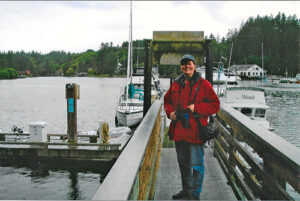 Lisa Mighetto is a sailor and historian living in Seattle. She is grateful to the Key Peninsula Historical Society for images, documents, and stories.
Lisa Mighetto is a sailor and historian living in Seattle. She is grateful to the Key Peninsula Historical Society for images, documents, and stories.

